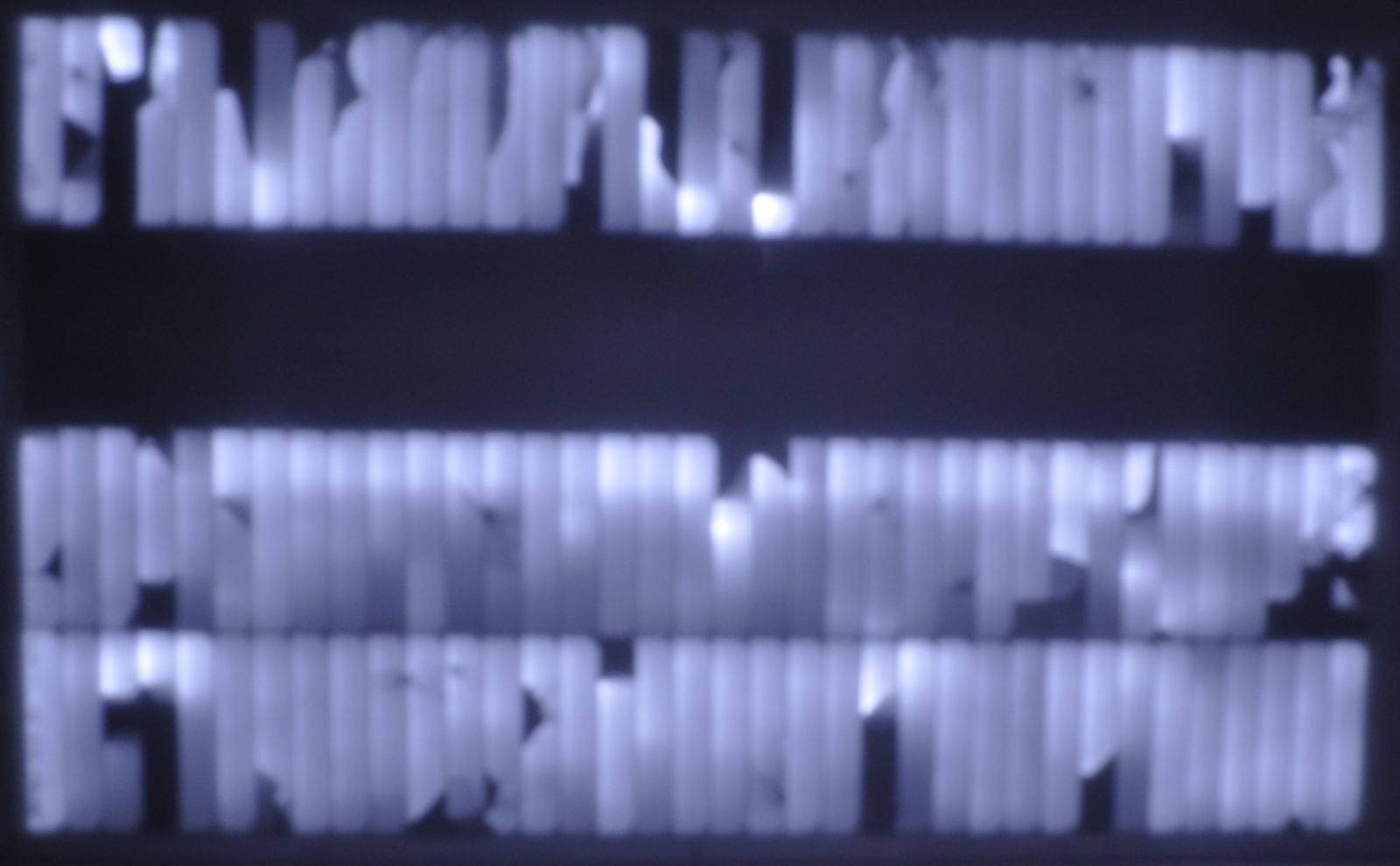Kimberley Karavan solar panel failures
Author: Solar 4 RVs
The lifespan of the factory fitted lightweight solar panels on Kimberley Karavans was found to be unacceptably short.
Even though we did not supply Kimberley Karavans with solar products we have received many phone calls and emails from Kimberley Kamper owners trying to find a solution. Our investigation has found a number of factors that cause the failures.
Cause of Solar Panel Failures on Kimberley Karavans
Brief overview:
The solar panel lifespan on Kimberley Karavans is short because of excessive thermo-mechanical stress at the cells and interconnects which gradually fracture lowering panel output; ultimately the fractures worsen becoming a complete open circuit with zero output from the panel.  The picture on the right is an Electroluminescence (EL) image of a solar panel which shows that one row of cells is open circuit with the other 3 rows nearly open circuit. The dark spots show where the cells are fully open circuit and the bright white spots show where the current is focused and will likely result in hot spots.
The picture on the right is an Electroluminescence (EL) image of a solar panel which shows that one row of cells is open circuit with the other 3 rows nearly open circuit. The dark spots show where the cells are fully open circuit and the bright white spots show where the current is focused and will likely result in hot spots.
The cause of this is:
- a mix of the thermo-mechanical relationships between roof, panel and the attachment between the two; and
As the roof cannot be changed, the problem needs to be fixed by a combination of the following:
- using more robust solar panels;
- using a different attachment method; and
Resolving short lifespan of solar panels on Kimberley Karavans
Main Issue
ISSUE 1 - Temperature/thermal cycling: Different materials have different expansion coefficients.
Cause of the problem
As materials heat up and cool down it creates stress at the interfaces between the materials. The cells expand the least followed by the copper, so any expansion of the roof creates a stretching stress on the cells and interconnects. Note that the plastic layers in the panel also expand, but they are not stiff like the roof so cannot apply any significant force on the cells and interconnects.
Avoiding/Fixing the problem
- Reduce maximum temperature and temperature variations – this is significantly improved by leaving a small gap between the roof and the solar panel.
- Use materials with low thermal expansion coefficient.
Manufacturing/Quality Issues
ISSUE 2 - Half cells used in original 55W panels: Half cells SunPower cells have only one inter-connection between cells and not three as in the case of full cells.
Cause of the problem
Stress (stretching forces) at the interconnects emanating from the longitudinal thermal expansion of the panel have to be absorbed by a single interconnect between the SunPower cells and not shared (divided) between 3 interconnects as in the full cell panels. I.e. With only one connection between each half-cell it needs to solely absorb the stretching forces which are created by the expansion of the roof.
Avoiding/Fixing the problem
- Using panels that are separated from the roof by a fixing method that allows the panels to expand and contract at an acceptable rate and/or the cells that are encased in a suitable method to protect them from the stress of thermal cycling of the roof
ISSUE 3 - Cell quality: There are a large number of grades (quality) of cells and poor quality cells may have been used.
Cause of the problem
There is a huge difference between high and low grade cells. Visually they can look the same and can only be assessed with a flash test and EL image.
Avoiding/Fixing the problem
- The manufacturer should perform an EL test on the panel to ensure no cells were cracked during production to prevent early failures
ISSUE 4 - solar panel backsheet: Backsheet with high thermal expansion and low tensile strength
Cause of the problem
High expanding, low tensile strength backsheets create and transmit more stress to the cells and interconnects, thereby reducing the lifespan of the panel. Manufacturers are driven by price and not lifespan of the panels they make. It’s a case of “buyer beware”, but this is very difficult as a consumer is not normally aware of the issues around the backsheet and it is virtually impossible even for a knowledgeable person to tell the difference between backsheet materials when the panel is new.
Avoiding/Fixing the problem
- The latest technology of encasing the cells in glass fibres which have very low coefficients of thermal expansion are important techniques required to ensure the panels last the lifespan of the vehicle
Installation site issues
ISSUE 5 - Roof material: Fibreglass thermal expansion is problematic
Cause of the problem
Virtually all fibreglass campers, caravans etc use polyester resin because it is the lowest cost of the resins available (it’s perfectly fine for its primary purpose), but the problem is it has the highest thermal expansion coefficient of the resins. Expansion is reduced by the glass fibre, but we know that some roofs still expand too much and will destroy panels bonded to the roof.
Avoiding/Fixing the problem
- Panels on fibreglass must have a suitable adhesive such as very high bond acrylic double sided tape or structural silicone between the panel and the roof.
ISSUE 6 - High temperature: Solar panels on insulated surfaces get extremely hot
Cause of the problem
The higher the temperature, the higher the stress, the higher the failure rate.
Avoiding/Fixing the problem
- A vented gap is between the panel and roof can reduce the panel temperature by up to around 15-20°C and even lower for the roof.
ISSUE 7 - Roof material breakdown: Fibreglass can weaken or break down
Cause of the problem
Fibreglass is stressed by high temperature and moisture which can result in yellowing/browning and fractures in the surface which then allows moisture to penetrate into the fibres. This can lead to the fibreglass weakening and losing some of its dimensional stability and expanding which further stresses the solar panel.
Avoiding/Fixing the problem
- Panels on fibreglass must not have sealed air gaps between them
Solution
Sunman produce the only Clean Energy Council Australia approved lightweight solar panel on the market. This means the modules have passed testing to show suitability for long-term outdoor use. These modules do this by using conventional cells, conventional busbars, but importantly a composite lamination material similar to aircraft windows. This gives the panel a coefficient of thermal expansion similar to glass solar panels.
These modules are the only trusted lightweight modules to be installed in mass on government buildings and have been designed specifically for Australian conditions. There are several major projects with eArc panels such as the Sydney Maritime Museum which has 235kW of eArc modules installed.
Sunman have produced a module the same size as the original Kimberley panels so the original panels can simply be removed and the eArc panels can cost-effectively be installed in their place.
See how the lamination material protects the cells from damage from stress





























